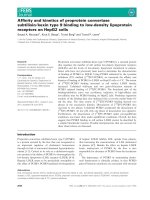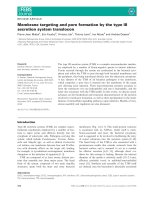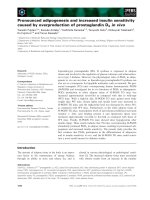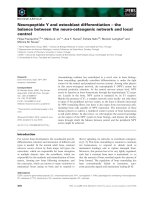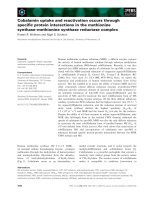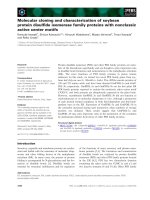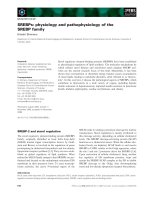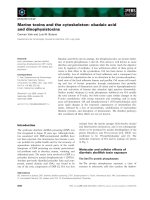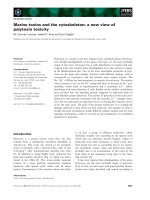Báo cáo khoa học: "Revision Learning and its Application to Part-of-Speech Tagging" pptx
Bạn đang xem bản rút gọn của tài liệu. Xem và tải ngay bản đầy đủ của tài liệu tại đây (196.44 KB, 8 trang )
Revision Learning and its Application to Part-of-Speech Tagging
Tetsuji Nakagawa
∗
and Taku Kudo and Yuji Matsumoto
,{taku-ku,matsu}@is.aist-nara.ac.jp
Graduate School of Information Science
Nara Institute of Science and Technology
8916−5 Takayama, Ikoma, Nara 630−0101, Japan
Abstract
This paper presents a revision learn-
ing method that achieves high per-
formance with small computational
cost by combining a model with high
generalization capacity and a model
with small computational cost. This
method uses a high capacity model to
revise the output of a small cost model.
We apply this method to English part-
of-speech tagging and Japanese mor-
phological analysis, and show that the
method performs well.
1 Introduction
Recently, corpus-based approaches have been
widely studied in many natural language pro-
cessing tasks, such as part-of-speech (POS) tag-
ging, syntactic analysis, text categorization and
word sense disambiguation. In corpus-based
natural language processing, one important is-
sue is to decide which learning model to use.
Various learning models have been studied such
as Hidden Markov models (HMMs) (Rabiner
and Juang, 1993), decision trees (Breiman et
al., 1984) and maximum entropy models (Berger
et al., 1996). Recently, Support Vector Ma-
chines (SVMs) (Vapnik, 1998; Cortes and Vap-
nik, 1995) are getting to be used, which are
supervised machine learning algorithm for bi-
nary classification. SVMs have good generaliza-
tion performance and can handle a large num-
ber of features, and are applied to some tasks
∗
Presently with Oki Electric Industry
successfully (Joachims, 1998; Kudoh and Mat-
sumoto, 2000). However, their computational
cost is large and is a weakness of SVMs. In
general, a trade-off between capacity and com-
putational cost of learning models exists. For
example, SVMs have relatively high generaliza-
tion capacity, but have high computational cost.
On the other hand, HMMs have lower compu-
tational cost, but have lower capacity and dif-
ficulty in handling data with a large number of
features. Learning models with higher capac-
ity may not be of practical use because of their
prohibitive computational cost. This problem
becomes more serious when a large amount of
data is used.
To solve this problem, we propose a revision
learning method which combines a model with
high generalization capacity and a model with
small computational cost to achieve high per-
formance with small computational cost. This
method is based on the idea that processing the
entire target task using a model with higher ca-
pacity is wasteful and costly, that is, if a large
portion of the task can be processed easily using
a model with small computational cost, it should
be pro cessed by such a model, and only difficult
portion should be pro cessed by the mo del with
higher capacity.
Revision learning can handle a general multi-
class classification problem, which includes POS
tagging, text categorization and many other
tasks in natural language processing. We ap-
ply this method to English POS tagging and
Japanese morphological analysis.
This paper is organized as follows: Section
2 describes the general multi-class classification
Computational Linguistics (ACL), Philadelphia, July 2002, pp. 497-504.
Proceedings of the 40th Annual Meeting of the Association for
problem and the one-versus-rest method which
is known as one of the solutions for the prob-
lem. Section 3 introduces revision learning, and
discusses how to combine learning models. Sec-
tion 4 describes one way to conduct Japanese
morphological analysis with revision learning.
Section 5 shows experimental results of English
POS tagging and Japanese morphological anal-
ysis with revision learning. Section 6 discusses
related works, and Section 7 gives conclusion.
2 Multi-Class Classification
Problems and the One-versus-Rest
Method
Let us consider the problem to decide the class
of an example x among multiple classes. Such a
problem is called multi-class classification prob-
lem. Many tasks in natural language processing
such as POS tagging are regarded as a multi-
class classification problem. When we only have
binary (positive or negative) classification algo-
rithm at hand, we have to reformulate a multi-
class classification problem into a binary classi-
fication problem. We assume a binary classifier
f(x) that returns positive or negative real value
for the class of x, where the absolute value |f (x)|
reflects the confidence of the classification.
The one-versus-rest method is known as one
of such methods (Allwein et al., 2000). For one
training example of a multi-class problem, this
method creates a positive training example for
the true class and negative training examples
for the other classes. As a result, positive and
negative examples for each class are generated.
Suppose we have five candidate classes A, B, C,
D and E , and the true class of x is B. Fig-
ure 1 (left) shows the created training examples.
Note that there are only two labels (positive and
negative) in contrast with the original problem.
Then a binary classifier for each class is trained
using the examples, and five classifiers are cre-
ated for this problem. Given a test example x
,
all the classifiers classify the example whether
it belongs to a specific class or not. Its class
is decided by the classifier that gives the largest
value of f(x
). The algorithm is shown in Figure
2 in a pseudo-code.
x
A :
B :
C :
D :
E :
Training Data
O
X
X
X
X
A
E
B
C
D
A :
B :
Training Data
O
X
1
2
3
Rank
A
E
B
C
D
4
5
x
x
x
x
x
x
x
x
-X
-O
-X
-X
-X
-X
-O
O
X
Label
: Positive
: Negative
Class Class
Figure 1: One-versus-Rest Method (left) and
Revision Learning (right)
# Training Procedure of One-versus-Rest
# This procedure is given training examples
# {(x
i
, y
i
)}, and creates classifiers.
# C = {c
0
, . . . , c
k−1
}: the set of classes,
# x
i
: the ith training example,
# y
i
∈ C: the class of x
i
,
# k: the number of classes,
# l: the number of training examples,
# f
c
(·): the binary classifier for the class c
# (see the text).
procedure T rain
OV R
({(x
0
, y
0
), . . . , (x
l−1
, y
l−1
)})
begin
# Create the training data with binary label
for i := 0 to l − 1
begin
for j := 0 to k − 1
begin
if c
j
= y
i
then
Add x
i
to the training data for the class c
j
as a
negative example.
else
Add x
i
to the training data for the class c
j
as a
p ositive example.
end
end
# Train the binary classifiers
for j := 0 to k − 1
Train the classifier f
c
j
(·) using the training data.
end
# Test Function of One-versus-Rest
# This function is given a test example and
# returns the predicted class of it.
# C = {c
0
, . . . , c
k−1
}: the set of classes,
# x: the test example,
# k: the number of classes,
# f
c
(·): binary classifier trained with the
# algorithm above.
function T est
OV R
(x)
begin
for j := 0 to k − 1
confidence
j
:= f
c
j
(x)
return c
argmax
j
confidence
j
end
Figure 2: Algorithm of One-versus-Rest
However, this method has the problem of be-
ing computationally costly in training, because
the negative examples are created for all the
classes other than the true class, and the to-
tal number of the training examples becomes
large (which is equal to the number of original
training examples multiplied by the number of
classes). The computational cost in testing is
also large, because all the classifiers have to work
on each test example.
3 Revision Learning
As discussed in the previous section, the one-
versus-rest method has the problem of compu-
tational cost. This problem become more se-
rious when costly binary classifiers are used or
when a large amount of data is used. To cope
with this problem, let us consider the task of
POS tagging. Most portions of POS tagging is
not so difficult and a simple POS-based HMMs
learning
1
achieves more than 95% accuracy sim-
ply using the POS context (Brants, 2000). This
means that the low capacity model is enough
to do most portions of the task, and we need
not use a high accuracy but costly algorithm in
every portion of the task. This is the base mo-
tivation of the revision model we are proposing
here.
Revision learning uses a binary classifier with
higher capacity to revise the errors made by
the stochastic model with lower capacity as fol-
lows: During the training phase, a ranking is
assigned to each class by the stochastic model
for a training example, that is, the candidate
classes are sorted in descending order of its con-
ditional probability given the example. Then,
the classes are checked in their ranking order to
create binary classifiers as follows. If the class
is incorrect (i.e. it is not equal to the true class
for the example), the example is added to the
training data for that class as a negative exam-
ple, and the next ranked class is checked. If
the class is correct, the example is added to the
training data for that class as a positive exam-
1
HMMs can be applied to either of unsupervised or
sup ervised learning. In this paper, we use the latter case,
i.e., visible Markov Models, where POS-tagged data is
used for training.
ple, and the remaining ranked classes are not
taken into consideration (Figure 1, right). Us-
ing these training data, binary classifiers are cre-
ated. Note that each classifier is a pure binary
classifier regardless with the number of classes
in the original problem. The binary classifier is
trained just for answering whether the output
from the stochastic model is correct or not.
During the test phase, first the ranking of
the candidate classes for a given example is as-
signed by the stochastic model as in the training.
Then the binary classifier classifies the example
according to the ranking. If the classifier an-
swers the example as incorrect, the next high-
est ranked class becomes the next candidate for
checking. But if the example is classified as cor-
rect, the class of the classifier is returned as the
answer for the example. The algorithm is shown
in Figure 3.
The amount of training data generated in the
revision learning can be much smaller than that
in one-versus-rest. Since, in revision learning,
negative examples are created only when the
stochastic model fails to assign the highest prob-
ability to the correct POS tag, whereas negative
examples are created for all but one class in the
one-versus-rest method. Moreover, testing time
of the revision learning is shorter, because only
one classifier is called as far as it answers as cor-
rect, but all the classifiers are called in the one-
versus-rest method.
4 Morphological Analysis with
Revision Learning
We introduced revision learning for multi-class
classification in the previous section. How-
ever, Japanese morphological analysis cannot be
regarded as a simple multi-class classification
problem, because words in a sentence are not
separated by spaces in Japanese and the mor-
phological analyzer has to segment the sentence
into words as well as to decide the POS tag of
the words. So in this section, we describe how
to apply revision learning to Japanese morpho-
logical analysis.
For a given sentence, a lattice consisting of all
possible morphemes can be built using a mor-
# Training Procedure of Revision Learning
# This procedure is given training examples
# {(x
i
, y
i
)}, and creates classifiers.
# C = {c
0
, . . . , c
k−1
}: the set of classes,
# x
i
: the ith training example,
# y
i
∈ C: the class of x
i
,
# k: the number of classes,
# l: the number of training examples,
# n
i
: the ordered indexes of C
# (see the following code),
# f
c
(·): the binary classifier for the class c
# (see the text).
procedure T rain
RL
({(x
0
, y
0
), . . . , (x
l−1
, y
l−1
)})
begin
# Create the training data with binary label
for i := 0 to l − 1
begin
Call the stochastic model to obtain the
ordered indexes {n
0
, . . . , n
k−1
}
such that P (c
n
0
|x
i
) ≥ · · · ≥ P (c
n
k−1
|x
i
).
for j := 0 to k − 1
begin
if c
n
j
= y
i
then
Add x
i
to the training data for the class c
n
j
as a
negative example.
else
begin
Add x
i
to the training data for the class c
n
j
as a
p ositive example.
break
end
end
end
# Train the binary classifiers
for j := 0 to k − 1
Train the classifier f
c
j
(·) using the training data.
end
# Test Function of Revision Learning
# This function is given a test example and
# returns the predicted class of it.
# C = {c
0
, . . . , c
k−1
}: the set of classes,
# x: the test example,
# k: the number of classes,
# n
i
: the ordered indexes of C
# (see the following code),
# f
c
(·): binary classifier trained with the
# algorithm above.
function T est
RL
(x)
begin
Call the stochastic model to obtain the
ordered indexes { n
0
, . . . , n
k−1
}
such that P (c
n
0
|x) ≥ · · · ≥ P (c
n
k−1
|x).
for j := 0 to k − 1
if f
c
n
j
(x) > 0 then
return c
n
j
return undecidable
end
Figure 3: Algorithm of Revision Learning
pheme dictionary as in Figure 4. Morphological
analysis is conducted by choosing the most likely
path on it. We adopt HMMs as the stochastic
model and SVMs as the binary classifier. For
any sub-paths from the beginning of the sen-
tence (BOS) in the lattice, its generative prob-
ability can be calculated using HMMs (Nagata,
1999). We first pick up the end node of the
sentence as the current state node, and repeat
the following revision learning process backward
until the beginning of the sentence. Rankings
are calculated by HMMs to all the nodes con-
nected to the current state node, and the best
of these nodes is identified based on the SVMs
classifiers. The selected node then becomes the
current state node in the next round. This can
be seen as SVMs deciding whether two adjoining
nodes in the lattice are connected or not.
In Japanese morphological analysis, for any
given morpheme µ, we use the following features
for the SVMs:
1. the POS tags, the lexical forms and the in-
flection forms of the two morphemes pre-
ceding µ;
2. the POS tags and the lexical forms of the
two morphemes following µ;
3. the lexical form and the inflection form of
µ.
The preceding morphemes are unknown because
the processing is conducted from the end of the
sentence, but HMMs can predict the most likely
preceding morphemes, and we use them as the
features for the SVMs.
English POS tagging is regarded as a special
case of morphological analysis where the seg-
mentation is done in advance, and can be con-
ducted in the same way. In English POS tag-
ging, given a word w, we use the following fea-
tures for the SVMs:
1. the POS tags and the lexical forms of the
two words preceding w, which are given by
HMMs;
2. the POS tags and the lexical forms of the
two words following w;
3. the lexical form of w and the prefixes and
suffixes of up to four characters, the exis-
BOS EOS
kinou (yesterday)
[noun]
ki (tree)
[noun]
nou (brain)
[noun]
ki (come)
[verb]
no
[particle]
u
[auxiliary]
gakkou (school)
[noun]
sentence:
ni (to)
[particle]
ni (resemble)
[verb]
it (went)
[verb]
ta
[auxiliary]
kinou
gakkou
it
ki
ki
noun
verb
noun
verb
noun
Dictionary:
Lattice:
"kinougakkouniitta (I went to school yesterday)"
Figure 4: Example of Lattice for Japanese Morphological Analysis
tence of numerals, capital letters and hy-
phens in w.
5 Experiments
This section gives experimental results of En-
glish POS tagging and Japanese morphological
analysis with revision learning.
5.1 Experiments of English
Part-of-Speech Tagging
Experiments of English POS tagging with revi-
sion learning (RL) are performed on the Penn
Treebank WSJ corpus. The corpus is randomly
separated into training data of 41,342 sentences
and test data of 11,771 sentences. The dictio-
nary for HMMs is constructed from all the words
in the training data.
T3 of ICOPOST release 0.9.0 (Schr¨oder,
2001) is used as the stochastic model for ranking
stage. This is equivalent to POS-based second
order HMMs. SVMs with second order polyno-
mial kernel are used as the binary classifier.
The results are compared with TnT (Brants,
2000) based on second order HMMs, and with
POS tagger using SVMs with one-versus-rest (1-
v-r) (Nakagawa et al., 2001).
The accuracies of those systems for known
words, unknown words and all the words are
shown in Table 1. The accuracies for b oth
known words and unknown words are improved
through revision learning. However, revision
learning could not surpass the one-versus-rest.
The main difference in the accuracies stems from
those for unknown words. The reason for that
seems to be that the dictionary of HMMs for
POS tagging is obtained from the training data,
as a result, virtually no unknown words exist in
the training data, and the HMMs never make
mistakes for unknown words during the train-
ing. So no example of unknown words is avail-
able in the training data for the SVM reviser.
This is problematic: Though the HMMs handles
unknown words with an exceptional method,
SVMs cannot learn about errors made by the
unknown word processing in the HMMs. To
cope with this problem, we force the HMMs
to make mistakes by eliminating low frequent
words from the dictionary. We eliminated the
words appearing only once in the training data
so as to make SVMs to learn about unknown
words. The results are shown in Table 1 (row
“cutoff-1”). Such procedure improves the accu-
racies for unknown words.
One advantage of revision learning is its small
computational cost. We compare the computa-
tion time with the HMMs and the one-versus-
rest. We also use SVMs with linear kernel func-
tion that has lower capacity but lower computa-
tional cost compared to the second order poly-
nomial kernel SVMs. The experiments are per-
formed on an Alpha 21164A 500MHz processor.
Table 2 shows the total number of training ex-
amples, training time, testing time and accu-
racy for each of the five systems. The training
time and the testing time of revision learning
are considerably smaller than those of the one-
versus-rest. Using linear kernel, the accuracy
decreases a little, but the computational cost is
much lower than the second order polynomial
kernel.
Accuracy (Known Words / Unknown Words) Number of Errors
T3 Original 96.59% (96.90% / 82.74%) 9720
with RL 96.93% (97.23% / 83.55%) 8734
with RL (cutoff-1) 96.98% (97.25% / 85.11%) 8588
TnT 96.62% (96.90% / 84.19%) 9626
SVMs 1-v-r 97.11% (97.34% / 86.80%) 8245
Table 1: Result of English POS Tagging
Total Number of Training Time Testing Time Accuracy
Examples for SVMs (hour) (second)
T3 Original — 0.004 89 96.59%
with RL (polynomial kernel, cutoff-1) 1027840 16 2089 96.98%
with RL (linear kernel, cutoff-1) 1027840 2 129 96.94%
TnT — 0.002 4 96.62%
SVMs 1-v-r 999984×50 625 55239 97.11%
Table 2: Computational Cost of English POS Tagging
5.2 Experiments of Japanese
Morphological Analysis
We use the RWCP corpus and some additional
spoken language data for the experiments of
Japanese morphological analysis. The corpus is
randomly separated into training data of 33,831
sentences and test data of 3,758 sentences. As
the dictionary for HMMs, we use IPADIC ver-
sion 2.4.4 with 366,878 morphemes (Matsumoto
and Asahara, 2001) which is originally con-
structed for the Japanese morphological ana-
lyzer ChaSen (Matsumoto et al., 2001).
A POS bigram model and ChaSen version
2.2.8 based on variable length HMMs are used as
the stochastic mo dels for the ranking stage, and
SVMs with the second order polynomial kernel
are used as the binary classifier.
We use the following values to evaluate
Japanese morphological analysis:
recall =
# of correct morphemes in system’s output
# of morphemes in test data
,
precision =
# of correct morphemes in system’s output
# of morphemes in system’s output
,
F-measure =
2 × recall × precision
recall + precision
.
The results of the original systems and those
with revision learning are shown in Table 3,
which provides the recalls, precisions and F-
measures for two cases, namely segmentation
(i.e. segmentation of the sentences into mor-
phemes) and tagging (i.e. segmentation and
POS tagging). The one-versus-rest method is
not used because it is not applicable to mor-
phological analysis of non-segmented languages
directly.
When revision learning is used, all the mea-
sures are improved for both POS bigram and
ChaSen. Improvement is particularly clear for
the tagging task.
The numbers of correct morphemes for each
POS category tag in the output of ChaSen with
and without revision learning are shown in Ta-
ble 4. Many particles are correctly revised by
revision learning. The reason is that the POS
tags for particles are often affected by the fol-
lowing words in Japanese, and SVMs can revise
such particles because it uses the lexical forms of
the following words as the features. This is the
advantage of our method compared to simple
HMMs, because HMMs have difficulty in han-
dling a lot of features such as the lexical forms
of words.
6 Related Works
Our proposal is to revise the outputs of a
stochastic model using binary classifiers. Brill
studied transformation-based error-driven learn-
ing (TBL) (Brill, 1995), which conducts POS
tagging by applying the transformation rules to
the POS tags of a given sentence, and has a
resemblance to revision learning in that the sec-
ond model revises the output of the first model.
Word Segmentation Tagging Training Testing
Time Time
Recall Precision F-measure Recall Precision F-measure (hour) (second)
POS Original 98.06% 98.77% 98.42% 95.61% 96.30% 95.96% 0.02 8
bigram with RL 99.06% 99.27% 99.16% 98.13% 98.33% 98.23% 11 184
ChaSen Original 99.06% 99.20% 99.13% 97.67% 97.81% 97.74% 0.05 15
with RL 99.22% 99.34% 99.28% 98.26% 98.37% 98.32% 6 573
Table 3: Result of Morphological Analysis
Part-of-Speech # in Test Data Original with RL Difference
Noun 41512 40355 40556 +201
Prefix 817 781 784 +3
Verb 8205 8076 8115 +39
Adjective 678 632 655 +23
Adverb 779 735 750 +15
Adnominal 378 373 373 0
Conjunction 258 243 243 0
Particle 20298 19686 19942 +256
Auxiliary 4419 4333 4336 +3
Interjection 94 90 91 +1
Symbol 15665 15647 15651 +4
Others 1 1 1 0
Filler 43 36 36 0
Table 4: The Number of Correctly Tagged Morphemes for Each POS Category Tag
However, our method differs from TBL in two
ways. First, our revision learner simply answers
whether a given pattern is correct or not, and
any types of binary classifiers are applicable.
Second, in our model, the second learner is ap-
plied to the output of the first learner only once.
In contrast, rewriting rules are applied repeat-
edly in the TBL.
Recently, combinations of multiple learners
have been studied to achieve high performance
(Alpaydm, 1998). Such methodologies to com-
bine multiple learners can be distinguished into
two approaches: one is the multi-expert method
and the other is the multi-stage method. In the
former, each learner is trained and answers inde-
pendently, and the final decision is made based
on those answers. In the latter, the multiple
learners are ordered in series, and each learner is
trained and answers only if the previous learner
rejects the examples. Revision learning belongs
to the latter approach. In POS tagging, some
studies using the multi-expert method were con-
ducted (van Halteren et al., 2001; M`arquez et
al., 1999), and Brill and Wu (1998) combined
maximum entropy models, TBL, unigram and
trigram, and achieved higher accuracy than any
of the four learners (97.2% for WSJ corpus).
Regarding the multi-stage methods, cascading
(Alpaydin and Kaynak, 1998) is well known,
and Even-Zohar and Roth (2001) proposed the
sequential learning model and applied it to POS
tagging. Their methods differ from revision
learning in that each learner behaves in the same
way and more than one learner is used in their
methods, but in revision learning the stochastic
model assigns rankings to candidates and the bi-
nary classifier selects the output. Furthermore,
mistakes made by a former learner are fatal in
their methods, but is not so in revision learn-
ing because the binary classifier works to revise
them.
The advantage of the multi-expert method is
that each learner can help each other even if
it has some weakness, and generalization er-
rors can be decreased. On the other hand,
the computational cost becomes large because
each learner is trained using every training data
and answers for every test data. In contrast,
multi-stage methods can decrease the computa-
tional cost, and seem to be effective when a large
amount of data is used or when a learner with
high computational cost such as SVMs is used.
7 Conclusion
In this paper, we proposed the revision learning
method which combines a stochastic model and
a binary classifier to achieve higher performance
with lower computational cost. We applied it to
English POS tagging and Japanese morpholog-
ical analysis, and showed improvement of accu-
racy with small computational cost.
Compared to the conventional one-versus-rest
method, revision learning has much lower com-
putational cost with almost comparable accu-
racy. Furthermore, it can be applied not only to
a simple multi-class classification task but also
to a wider variety of problems such as Japanese
morphological analysis.
Acknowledgments
We would like to thank Ingo Schr¨oder for making
ICOPOST publicly available.
References
Erin L. Allwein, Robert E. Schapire, and Yoram
Singer. 2000. Reducing Multiclass to Binary: A
Unifying Approach for Margin Classifiers. In Pro-
ceedings of 17th International Conference on Ma-
chine Learning, pages 9–16.
Ethem Alpaydin and Cenk Kaynak. 1998. Cascad-
ing Classifiers. Kybernetika, 34(4):369–374.
Ethem Alpaydm. 1998. Techniques for Combining
Multiple Learners. In Proceedings of Engineering
of Intelligent Systems ’98 Conference.
Adam L. Berger, Stephen A. Della Pietra, and Vin-
cent J. Della Pietra. 1996. A Maximum Entropy
Approach to Natural Language Processing. Com-
putational Linguistics, 22(1):39–71.
Thorsten Brants. 2000. TnT — A Statistical
Part-of-Speech Tagger. In Proceedings of ANLP-
NAACL 2000, pages 224–231.
Leo Breiman, Jerome H. Friedman, Richard A. Ol-
shen, and Charles J. Stone. 1984. Classification
and Regression Trees. Wadsworth and Brooks.
Eric Brill and Jun Wu. 1998. Classifier Combi-
nation for Improved Lexical Disambiguation. In
Proceedings of the Thirty-Sixth Annual Meeting of
the Association for Computational Linguistics and
Seventeenth International Conference on Compu-
tational Linguistics, pages 191–195.
Eric Brill. 1995. Transformation-Based Error-
Driven Learning and Natural Language Process-
ing: A Case Study in Part-of-Speech Tagging.
Computational Linguistics, 21(4):543–565.
Corinna Cortes and Vladimir Vapnik. 1995. Support
Vector Networks. Machine Learning, 20:273–297.
Yair Even-Zohar and Dan Roth. 2001. A Sequential
Model for Multi-Class Classification. In Proceed-
ings of the 2001 Conference on Empirical Methods
in Natural Language Processing, pages 10–19.
Thorsten Joachims. 1998. Text Categorization with
Support Vector Machines: Learning with Many
Relevant Features. In Proceedings of the 10th Eu-
ropean Conference on Machine Learning, pages
137–142.
Taku Kudoh and Yuji Matsumoto. 2000. Use of Sup-
port Vector Learning for Chunk Identification. In
Proceedings of the Fourth Conference on Compu-
tational Natural Language Learning, pages 142–
144.
Llui´ıs M`arquez, Horacio Rodr´ıguez, Josep Carmona,
and Josep Montolio. 1999. Improving POS Tag-
ging Using Machine-Learning Techniques. In Pro-
ceedings of 1999 Joint SIGDAT Conference on
Empirical Methods in Natural Language Process-
ing and Very Large Corpora, pages 53–62.
Yuji Matsumoto and Masayuki Asahara. 2001.
IPADIC User’s Manual version 2.2.4. Nara In-
stitute of Science and Technology. (in Japanese).
Yuji Matsumoto, Akira Kitauchi, Tatsuo Yamashita,
Yoshitaka Hirano, Hiroshi Matsuda, Kazuma
Takaoka, and Masayuki Asahara. 2001. Mor-
phological Analysis System ChaSen version 2.2.8
Manual. Nara Institute of Science and Technol-
ogy.
Masaaki Nagata. 1999. Japanese Language Process-
ing Based on Stochastic Models. Kyoto University,
Doctoral Thesis. (in Japanese).
Tetsuji Nakagawa, Taku Kudoh, and Yuji Mat-
sumoto. 2001. Unknown Word Guessing and
Part-of-Speech Tagging Using Support Vector Ma-
chines. In Proceedings of 6th Natural Language
Processing Pacific Rim Symposium, pages 325–
331.
Lawrence R. Rabiner and Biing-Hwang Juang.
1993. Fundamentals of Speech Recognition. PTR
Prentice-Hall.
Ingo Schr¨oder. 2001. ICOPOST — Ingo’s Collection
Of POS Taggers.
/~ingo/icopost/.
Hans van Halteren, Jakub Zavrel, and Walter Daele-
mans. 2001. Improving Accuracy in Word-
class Tagging through Combination of Machine
Learning Systems. Computational Linguistics,
27(2):199–230.
Vladimir Vapnik. 1998. Statistical Learning Theory.
Springer.
